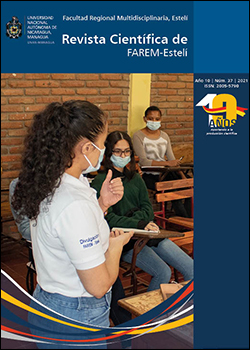Graphic Representation in the Civil Engineering career of the University of Holguin, Cuba
DOI:
https://doi.org/10.5377/farem.v0i37.11218Keywords:
Graphics Representation, Subject Program, Civil Engineering, Professional FormationAbstract
Abstract
The responsibility of the formation of professional skill in graphic expression in engineering students merits the use of mechanisms and forms of expression that constitute a fundamental tool of support to the interdisciplinary technological team with which they act particularly in the fields of construction. However, the changes occurred in the university environment with the application of the new study plans that were gradually implemented, the elimination of subject, the reduction of teaching hours, and the introduction of the new technologies of informatics and communications, as well as the non-incorporation in the teaching literature of the new Cuban norms approved and specificity of the existing basics bibliographies, have caused difficulties in the interpretation, representation, and solution of graphics problem. For this reason, the program of the subject Graphic Representation of the Civil Engineering career is elaborated, to provide the knowledge system for the student to form habits and skills developing the forms of the logical thinking and spatial imagination to be able to develop and manage projects in the exercise of their profession.
Downloads
References
Addine, F. (2004). Didáctica: teoría y práctica. Compilación. Editorial Pueblo y Educación.
Alonso, F.; Cruz; M. A. y Olaya, J. J. (2020). Dimensiones del proceso de enseñanza – aprendizaje para la formación profesional. Artículo Revista Luz. Año XIX. (2), pp. 17-29, abril-junio, 2020. Edición 83. III Época. ISSN 1814-151X. https://luz.uho.edu.cu
Arboleda y Álvarez (2010). Desarrollo de una guía básica de órdenes de autodesk inventor como medio gráfico para la enseñanza en la disciplina dibujo de la Universidad de Granma. Tesis en opción al título de Ingeniero en Diseño Gráfico Computarizado. Cuba.
Cañibano, Enrique A. (1987). Dibujo para Ingenieros Civiles
Dorta. L. (2015). Programa de asignatura para la formación económica de los ingenieros civiles. Trabajo de diploma en opción al título de Ingeniero Civil. Universidad Oscar Lucero Moya. Holguín.
Duarte, M. (2014). El dibujo y la expresión gráfica como herramientas fundamentales en la ingeniería industrial. Ingeniería Industrial. Actualidad y Nuevas Tendencias, vol. IV, núm. 13, diciembre, 2014, pp. 106-113. Universidad de Carabobo. Carabobo, Venezuela. http://www.redalyc.org/articulo.oa?id=215045726010.
González, Y. (2009). Modelo didáctico para la gestión del modo de actuación de dirección en el proceso de formación del profesional de Ingeniería Civil. Tesis en opción al título de Ingeniero Civil. Universidad de Holguín.
Guzmán, R.; Arnaiz, M. y Varela, L. (sf). Dibujo Básico. Libro de texto Disciplina Proyecto, Construcción y Conservación de Edificaciones en la carrera de Construcción. Universidad de Ciencias Pedagógicas. Camagüey.
Ministerio de Educación Superior. MES. (1989). Ciencias Técnicas. Plan de Estudio “C”. Ingeniería Civil. Modalidad Presencial (CRD).
MES (1999). Plan de Estudios de la carrera Ingeniería Civil. Perfeccionamiento del Plan C (Plan C´). Curso Regular Diurno.
MES (2007). Ciencias Técnicas. Plan de Estudio “D”. Ingeniería Civil. Modalidad Presencial (CRD).
MES (2018). Plan de Estudio “E”. Carrera Ingeniería Civil.
MES (2018a). Resolución Ministerial N° 2:2018. Reglamento de trabajo docente y metodológico de la educación superior.
Pérez J. y Palacios, S. (1998). Expresión Gráfica en la Ingeniería, Introducción al dibujo industrial. Universidad Carlos III de Madrid, Pearson Prentice Hall.
Urruaca, E. (2014) Programas educativos. http://www.monografias.com/trabajos4/programaseducativos /programas.shtml.
Published
Issue
Section
License
Copyright (c) 2021 Revista Científica de FAREM-Esteli

This work is licensed under a Creative Commons Attribution-NonCommercial-ShareAlike 4.0 International License.



